Pipeline
Lumeo's Pipeline makes it easy to process video, on the edge or in the cloud. It is a flexible, cloud-managed, video processing engine that can route, process, store and transform video and images.
Overview
Pipelines can be deployed to run on a variety of edge devices (aka Gateways) with support for accelerated inferencing using Nvidia GPUs and ML accelerators.
Pipeline Editor
The Pipeline Editor is a node-based editor that lets you build a video pipeline quickly. You can drag and drop nodes from the node library to the pipeline canvas and link them up to create your pipeline. For a list of Nodes and how they work, see Node Reference section.
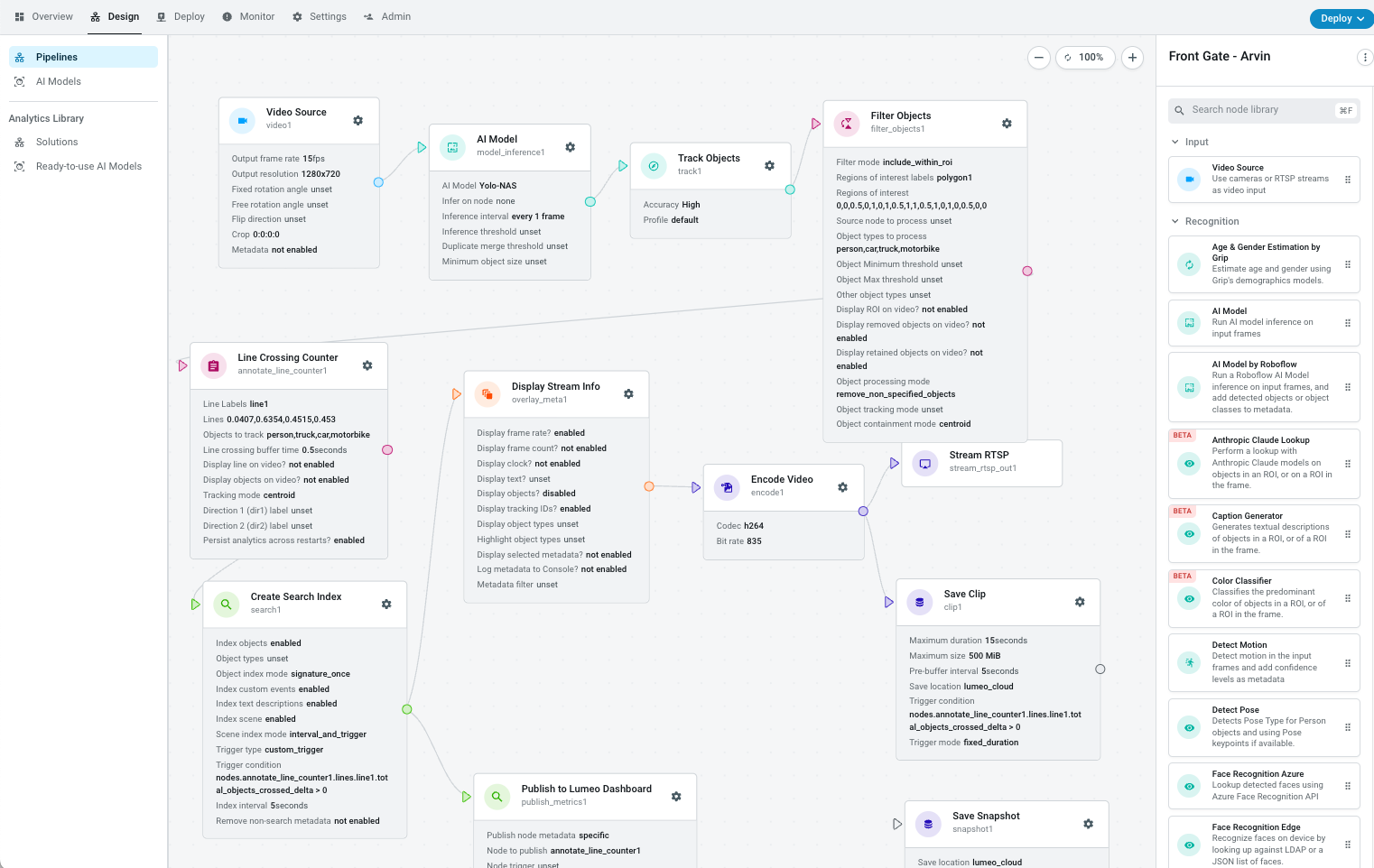
Nodes
A Pipeline is made up of one or more Nodes which can receive Video from Cameras & Streams, process it, and output files, Streams or metadata to your application.
Node Inputs & Outputs
When you hover over the Input (triangle) and Output (circle) connectors of a Node on the canvas, you can see the type of media that node expects at the input and what it outputs. In order to connect 2 nodes, the output media type of one must match the input media type of the other. The editor will not let you connect 2 nodes if their media types are incompatible.
The editor will also display the metadata that a node outputs along with the media. You can, however, connect 2 nodes that have different metadata (metadata is cumulative - each node simply adds that metadata to each frame it processes).
Lumeo supports the following media types in the pipeline:
Raw Video : These nodes output Raw video frames.
Encoded Video : These nodes output Encoded video frames.
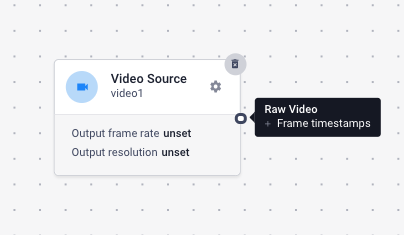
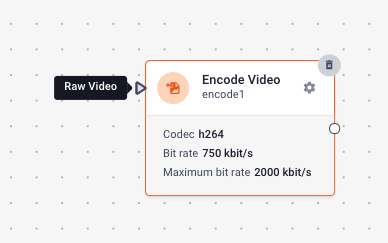
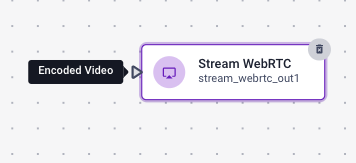
Node Properties
Some nodes have additional properties that you can configure by clicking on the gear icon on the node. Here's how the Node properties work:
- Properties specified here will apply to all the deployments for that Pipeline.
- Properties that are empty but required will need to be specified when deploying the pipeline.
- Properties specified here, but with the "Toggle to allow overriding property at deploy time" enabled will show up with these defaults but can be overridden when deploying the pipeline.
- Video Source node is unique in that the actual source of the video can only be specified when you Deploy that pipeline.
This allows you to create a "template" for the Pipeline, and then customize it for each deployment, for instance, on a different device or with a different video source.
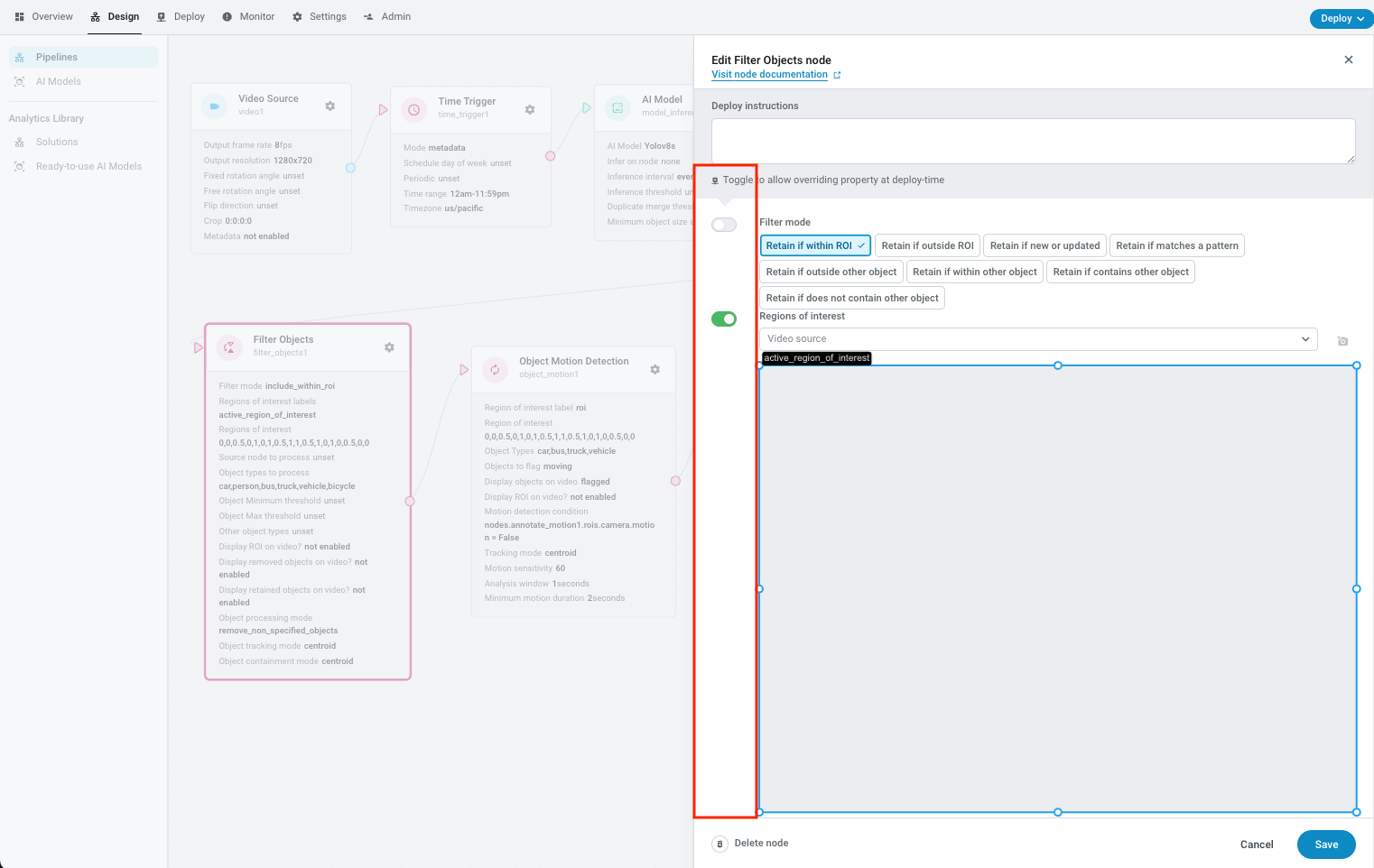
Node properties with "Toggle to allow overriding at deploy time" in red.
Node Metadata
Along with processing media, Pipeline also supports frame-level metadata that is carried along with each frame.
Built-in Metadata
Some nodes (such as Add Metadata Node , AI Model Node , Line Counter Node etc. ) will inject metadata into the frames that they process.
Here is an example of metadata carried in a pipeline that counts objects present in a given region of interest ( utilizing a Video Source Node and Presence Counter Node ).
In order to determine metadata flowing through your pipeline, refer to the documentation for each node that you are using.
{
"video1.source_type": "stream",
"video1.source_name": "Parking Lot test video",
"video1.source_id": "93077c84-b9ce-409f-966f-bdf2bbc7c242",
"nodes": {
"annotate_presence1": {
"type": "annotate_presence",
"rois": {
"roi1": {
"coords": [[1,1],
[100,100],
[200,200]],
"total_objects": 2,
"objects_entered_delta": 1,
"objects_exited_delta": 0,
"objects_above_max_time_threshold_count": 1,
"current_objects_count": 2,
"current_objects": {
"15069984211300461000": {
"first_seen": 20,
"time_present": 3600
},
"1506998428100461000": {
"first_seen": 22,
"time_present": 20
}
}
}
}
}
},
"objects": [
{
"attributes": [],
"probability": -0.10000000149011612,
"class_id": 0,
"rect": {
"top": 236.29208374023438,
"height": 15.62222957611084,
"left": 339.904052734375,
"width": 31.91175079345703
},
"id": 15069984211300461000,
"label": "car"
},
{
"attributes": [],
"probability": -0.10000000149011612,
"class_id": 0,
"rect": {
"top": 250.60275268554688,
"height": 19.088224411010742,
"left": 235.5812530517578,
"width": 35.78194046020508
},
"id": 1506998428100461000,
"label": "car"
},
],
}
}Extracting Metadata
Other nodes, such as Save Clip Node , Save Snapshot Node , Webhook Node let you save/send the metadata to external systems.
You can also add, extract or process metadata using the Function Node.
To log or display metadata on the video, use the Display Stream Info Node
Trigger Conditions
See also : Trigger Conditions Guide
Metadata can be utilized to trigger actions in some nodes. For instance, Save Clip Node can start a clip capture when some event happens.
These trigger conditions are written in a Dot-notation format, operating on top level properties in the metadata. They support the following operators:
- Comparison operators on numeric and string properties :
>, <, >=, <=, =, !=. ex.KEYPATH = "string"orKEYPATH > number - Booleans :
KEY_PATH - Combining conditions :
CONDITION and CONDITION,CONDITION or CONDITION
In the metadata example above, one could use the following condition:
nodes.annotate_presence1.rois.roi1.total_objects > 0 : Trigger anytime there are non zero objects in a region
usermetadata.value : Checks a boolean
Tip: If you need complex logic for the trigger, it is often easier to put that logic into a Function Node and add custom metadata to the frame :
if <complex_logic>:
frame.meta().set_field('usermetadata', {'value': True})
else:
frame.meta().set_field('usermetadata', {'value': False})
frame.meta().save().. which you can then use as a trigger in this node (ex. usermetadata.value)
Node Reference
See the Node Reference section for details about each node.
Pipeline / Solution Templates
You can find an ever growing list of ready-to-use pipeline templates in the Analytics Library, under Solutions.
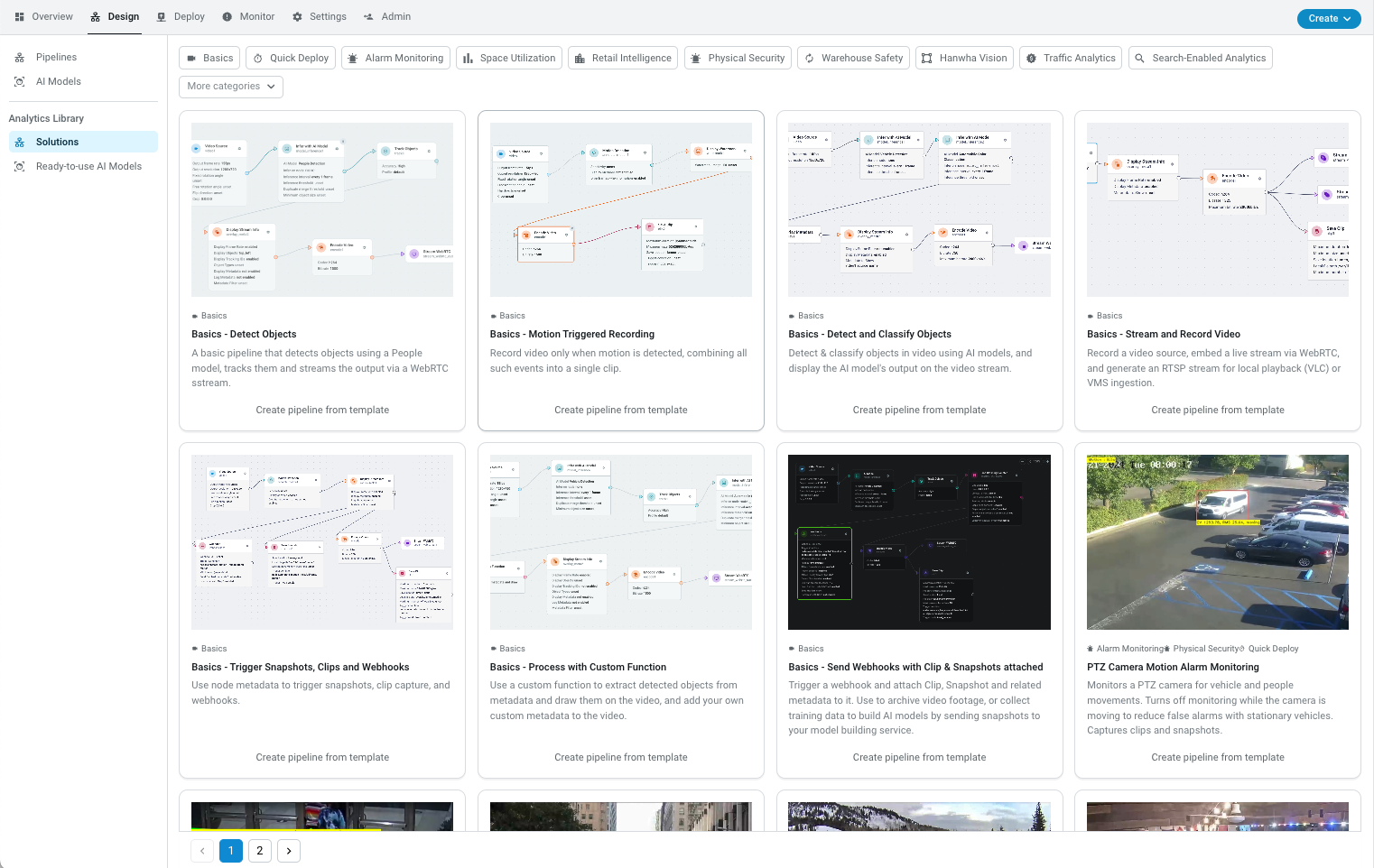
Pipeline Deployments
To run the Pipeline, you must deploy it with a specific video source on a Gateway.
See below for quick steps to deploy the PIpeline from the Pipeline editor, and then head over to Deployments page to learn more about managing deployments.
Deploy from Pipeline Editor
You can create a Deployment using the Deploy button in the Pipeline editor, or "Deploy pipeline" button from the Pipeline Deployments page. Deploying from the Pipeline editor is particularly helpful when building or tweaking a specific analytic.
As a part of the deployment process, you will select the source for Video Source nodes, pick a Gateway, and customize required node properties.
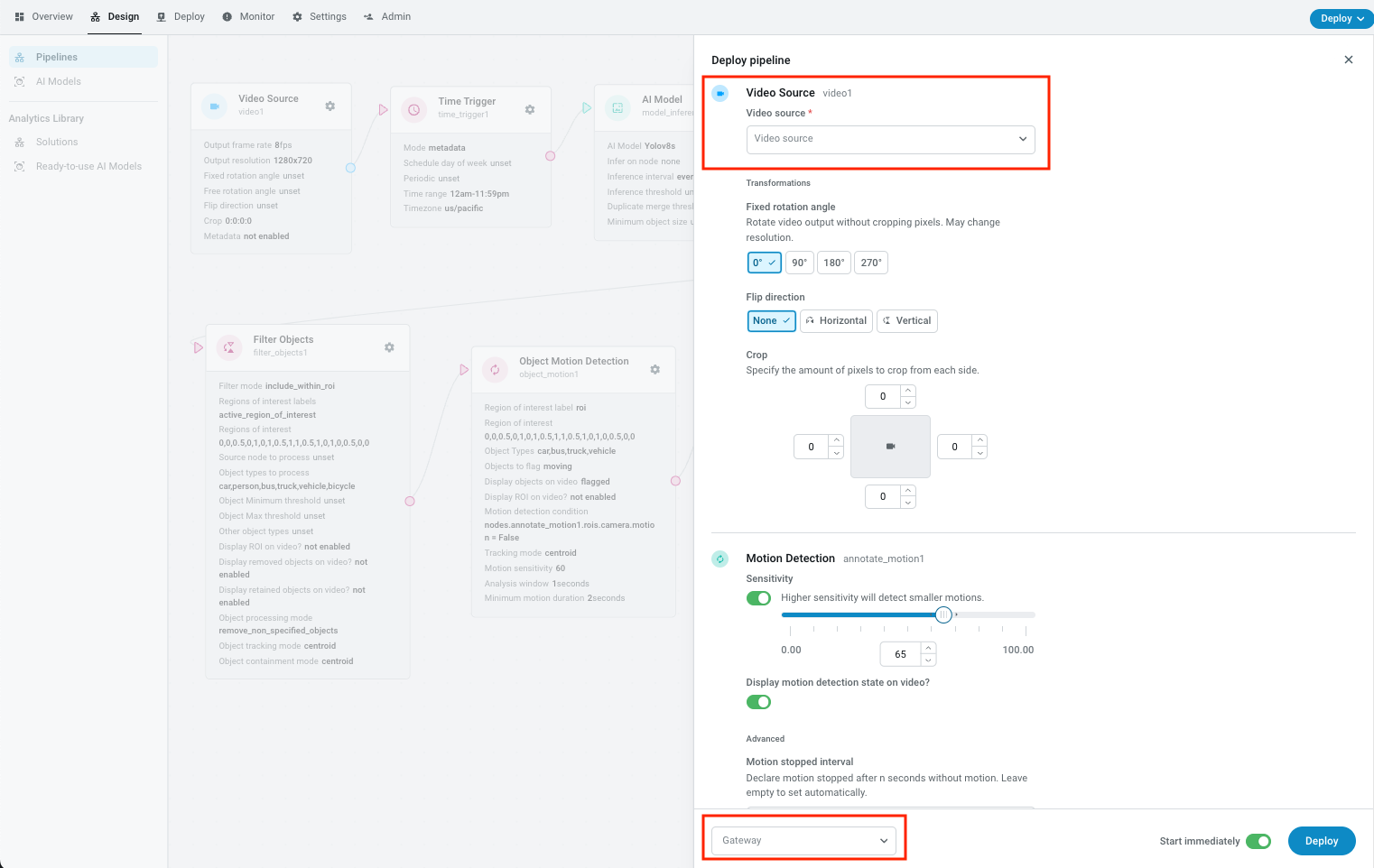
Deploy a pipeline. Selecting a Gateway first will limit sources to ones accessible by that gateway.
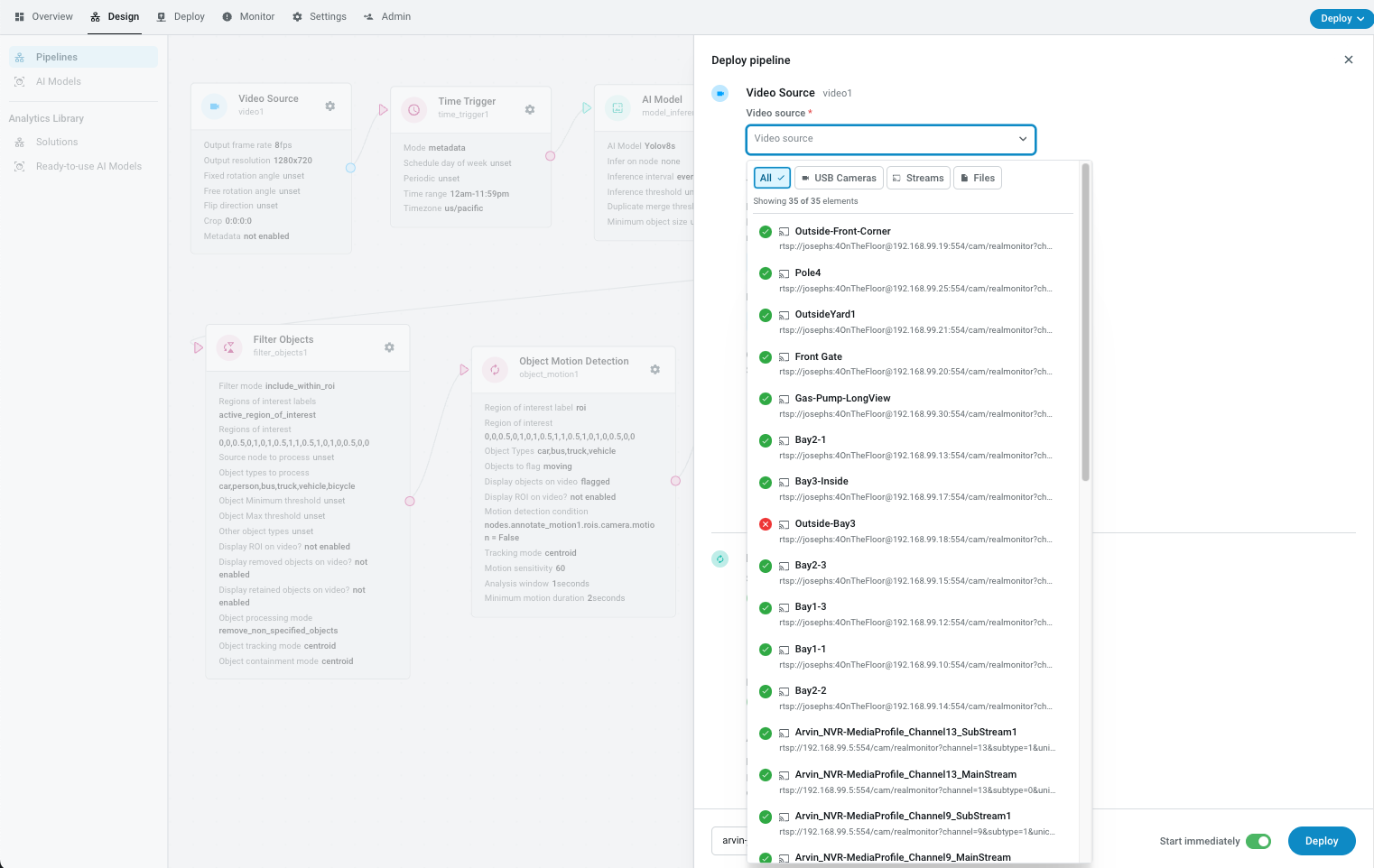
Select a video source. Selecting a source will limit Gateway choices to ones which can process this source.
Update a deployment
If you are updating the pipeline, you can use the Update deployments button from the Pipeline Editor to update existing deployments vs creating a new one every time. This is very helpful when you are building or debugging a Pipeline.
API Reference
See pipelines
Updated 3 months ago
